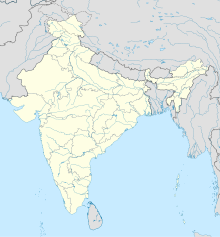Siege of Kampili
| Siege of Kampili | |||||||
|---|---|---|---|---|---|---|---|
| |||||||
| Belligerents | |||||||
|
| Kampili kingdom | ||||||
| Commanders and leaders | |||||||
|
Malik Zada Khwaja Jahan |
Kampilideva Kumara Rama | ||||||
Location within Karnataka | |||||||
The Siege of Kampili (1326–1327),[1] was a major conflict during the reign of Muhammad bin Tughlaq, sparked by the rebellion of his cousin, Bahaudin Gurshasp, governor of Sagar. After being defeated by the Sultan’s forces, Bahaudin sought refuge with the king of Kampili, giving Tughlaq an excuse to attack the kingdom. The Imperial forces, led by Malik Zada, faced strong resistance and were defeated twice at Kummata by the Kampili forces, who were supported by Reddi nobles. This alliance led the Reddis to adopt the title "Gujjaritattuvibhāla" (the destroyer of Gujjara Cavalry). The siege was an important event in South Indian history, showcasing the struggle between the Delhi Sultanate and Kampili kingdom for control of the Deccan.
Background
[edit]In 1327, Bahaudin Gurshasp, Muhammad bin Tughluq's first cousin and governor of Sagar, rebelled against the king and aimed for the Delhi throne. He attacked loyal chiefs, forcing them to seek refuge in Mando. Tughauq sent his Gujarat forces to defeat Bahaudin, who, despite his initial success, lost the battle due to the defection of his officer, Khizr Bahrani. Bahaudin fled to Sagar, then moved his family and wealth to Kampila, seeking protection from the Raya of Kampili. The shelter given to Bahaudin by its king offered Muhammad Tughluk a fine excuse to declare war on Kampili.[2]

The siege of Kampili was part of Muhammad bin Tughlaq's larger military campaigns in the Deccan, aimed at consolidating control in the region. The conflict was characterized by intense fighting and strategic maneuvers as both sides sought to gain the upper hand.[3][4] Overall, the siege of the Kampili under Muhammad bin Tughlaq was a significant episode in South Indian history, shaping the power dynamics and influence in the Deccan region during the 14th century.[5][6]
Battle
[edit]
Under the command of Malik Zada, the forces of the Delhi Sultanate were dispatched by the Emperor to advance against the Kampili kingdom.[7] The Imperial forces continued their pursuit of the rebels and laid siege to Kummata in the kingdom of Kampili, where they were defeated twice by the local Hindu forces. This may have been the occasion when the Reddi nobles, in alliance with the king of Kampili, defeated the Gujarat Imperial forces and adopted the title "Gujjaratattuvibhala." Vema, along with his brothers and relatives, likely allied with the Kampili king in this conflict against their common adversary, Muhammad-bin-Tughlaq. This event occurred in A.H. 727 (1326–27 CE).[1]
References
[edit]- ^ a b Sōmaśēkharaśarma, Mallampalli (1948). History of the Reddi Kingdoms (circa. 1325 A.D. to Circa 1448 A.D.). Andhra University. p. 64.
- ^ Sharma, M .H. THE HISTORY OF VIJAYANAGAR EMPIRE VOL.1. p. 12.
- ^ Ramanayya, N. Venkata (1942). The Early Muslim Expansion in South India. University of Madras. pp. 50–51.
- ^ Luniya, Bhanwarlal Nathuram (1978). Life and Culture in Medieval India. Kamal Prakashan. pp. 470–471.
- ^ Kainikara, Dr Sanu (2020-08-01). From Indus to Independence - A Trek Through Indian History: Vol VII Named for Victory : The Vijayanagar Empire. Vij Books India Pvt Ltd. ISBN 978-93-89620-52-8.
- ^ Sarma, P. Sree Rama (1992). A History of Vijayanagar Empire. Prabhakar Publications. pp. 12–13.
- ^ Gilmartin, David (2000). Beyond Turk and Hindu: Rethinking Religious Identities in Islamicate South Asia. University Press of Florida. pp. 300–306, 321–322. ISBN 978-0-8130-3099-9.


